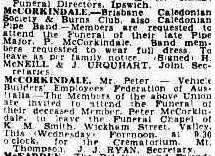This is Week 39 in my Beyond the Internet series in which I explore the sources of information beyond our computer screens and the topic is Funeral Directors’ Registers.
While it’s fairly automatic for us as genealogists to look for monumental inscriptions, or even just gravestones, funeral directors’ records are a less used resource. My suspicion is that this is because they’re less readily found online.
Why bother with funeral directors’ registers?
There are a few very good reasons:
- They are often available well beyond the timeframe of registered death indices. This means you can find out when someone died in the more recent past. You also don’t have to be a next-of-kin to be able to access the information.
- You can obtain information on the person’s death without the expense of buying the certificate if it’s not an immediate family member. It may also tell you additional details that are not recorded on the death certificate eg time of death (Scottish records always include this).
- They can, and often do, include cause of death as well as some biographical details for the deceased. They can also include surprising details for family members. For example I’ve found complete lists of adult children (including married daughters), their residence, ages and sometimes occupation. It may also provide clues of marriages beyond those available via indexes.
- You can get some sense of your family’s wealth, or lack of it, from the type of funeral they had, the cost of the coffin, hearses etc.
- You may learn of religious matters eg the recording of “rosary beads and crucifix in hands” or a Requiem Mass.
- They may mention lodge affiliations or whether a flag was on the coffin for an ex-serviceman.
- In rare cases it may be the only record available of the death or burial.
Where can I find these records?
Much will depend on how long the business has been in operation, whether it still exists, and how flexible they are about their records.
If you’re not sure, you could try post office directories and phone books to see if you can locate current contact information you might want to phone or email the company to see where they archive their records. Of course despite our obsessive need to know what happened to our distant relative, the funeral directors are more likely to have pressing current-day issues to deal with, so patience is a virtue to be practiced.

I’d also try approaching the local family history centre or reference library in the town where the business operated/operates. I know that the Genealogical Society of Queensland has several of the big-name Brisbane undertakers’ records on microfilm and indexed on microfiche. I wonder how often they’re used these days or if they languish unattended on the shelf. Your own society may have the indexes, at least, so you would know whether the original will hold what you’re looking for. I’ve found heaps of information from these and can heartily recommend them.
If the undertaker is from your home town, then you may have the added advantage of knowing that certain funeral directors were more likely to be chosen by particular religions eg KM Smith was the dominant funeral business for Catholic Brisbaneites. But don’t get wedded to which company they may have used, as they’re likely to upset the apple cart (as you’ll see from the funeral notice here, for my Presbyterian relations).
A register of archives for your state or county may also reveal archival holdings for funeral businesses.
How do you know which funeral directors’ registers to search?
I tend to the policy of checking them all –the scattergun approach – in the absence of strong information.
If you already have the death or funeral notice from the newspaper it will be very clear which funeral director buried your relative. Alternatively it may appear on other documentation or on the death notice (in Australia though not elsewhere in my experience).
The burial registers we looked at last week may also reveal this information. It does all tend to become a bit chicken-and-egg as to which records to search first, but it’s a case of turning over every possible stone in your quest.
Where to from here?
There are many times I’ve wished for funeral directors’ registers and they’ve been unavailable but on other occasions they’ve been a gold mine of information. It now occurs to me that there’s one stone I’ve left unturned so I need to take my own advice and follow it up.
You might wish to read this story via Genealogy’s Star, which highlights how pivotal these records were for one family, and revealed untold depths of sadness.
Have you had any grand successes using funeral directors’ registers?
NEXT WEEK: we take a turn through migration records.
Another interesting post, Pauleen. I like the scattergun approach to research…and use it regularly 😉
LikeLike
Thanks Fi. I think we’re all a little partial to scattergunning…have done a bit myself today.
LikeLike
This was a new set of records that had never occurred to me. I suppose the first challenge is finding what funeral director the family used. An intriguing idea to follow up.
LikeLike
Worth a go Susan…it usually says which funeral directors on the funeral/death notice -at least over here. Don’t know about UK unfortunately (still haven’t tracked down where my great-grandfather was buried in Glasgow).
LikeLike
Current URL for the lik to GSQ is
http://www.gsq.org.au/index.php/gsq-shop/gsq-publications/funeral-directors
LikeLike
Thanks -It’s obviously changed since I did the post. Pauleen
LikeLike